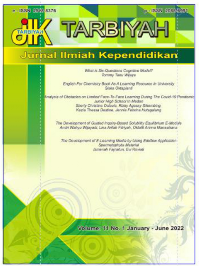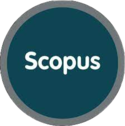What is Six-Questions Cognitive Model?
DOI:
https://doi.org/10.18592/tarbiyah.v11i1.5099Abstract
Knowledge transfer is not easy especially for mathematics. Various factors need to be considered and think about how to transfer the knowledge effectively. The traditional teaching method does not help students to achieve deep learning and to solve this problem, there is a need to new learning method. The 6-questions cognitive model is a new learning model that is developed in China in 2012. This model can stand on its own or be combined with technology-based learning media. This research aims to introduce the 6-questions cognitive model by using a qualitative method. Researchers did literature research to know the deeper meaning of the 6-questions cognitive model. The result of this research shows that the cognitive model can help students to achieve deep learning and it can also be combined with a technology-based learning media. Teachers can use this research result to teach mathematics in school. Future research can find out about the effect of 6-questions cognitive model on the students' high order thinking skill.References
Anderson, L. . W. (2001). A Taxonomy for Learning, Teaching, and Assessing: A Revision of Blooms Taxonomy of Educational Objectives. longman.
Babinčáková, M., Ganajová, M., Sotáková, I., & Bernard, P. (2020). Influence of formative assessment classroom techniques (Facts) on student’s outcomes in chemistry at secondary school. Journal of Baltic Science Education, 19(1), 36–49. https://doi.org/10.33225/jbse/20.19.36
Cunhua, L., Ying, Z., Qunzhuang, O., & Wijaya, T. T. (2019). Mathematics course design based on six questions cognitive theory using hawgent dynamic mathematic. Journal On Education, 02(01), 36–44.
Desania, F., Sinaga, B., Lubis, A., & Syahputra, E. (2020). Analysis of students’ critical thinking skills through problem-based learning approach using HOTS questions in SMA N 13 medan. International Journal of Scientific and Technology Research, 9(3), 131–137.
Dewi, S. N., Wijaya, T. T., Budianti, A., & Rohaeti, E. E. (2018). Pengaruh Model Teams Games Tournament Terhadap Kemampuan Pemahaman Matematik Siswa Kelas XI SMK di Kota Cimahi Pada Materi Fungsi Eksponen. WACANA AKADEMIKA: Majalah Ilmiah Kependidikan, 2(1), 99. https://doi.org/10.30738/wa.v2i1.2570
Dinni, H. N. (2018). HOTS ( High Order Thinking Skills ) dan Kaitannya dengan Kemampuan Literasi Matematika. Prisma, 1, 170–176.
Ilmi, A. M., Sukarmin, & Sunarno, W. (2020). Development of TPACK based-physics learning media to improve HOTS and scientific attitude. Journal of Physics: Conference Series, 1440(1). https://doi.org/10.1088/1742-6596/1440/1/012049
Kulsum, S. I., Hidayat, W., Wijaya, T. T., & Kumala, J. (2019). Analysis on high school students’ mathematical creative thinking skills on the topic of sets. Jurnal Cendekia : Jurnal Pendidikan Matematika, 03(02), 431–436. https://doi.org/https://doi.org/10.31004/cendekia.v3i2
Lin, Y., Zhou, Y., Wang, S., & Wijaya, T. T. (2020). Lesson design of geometric sequences based on the 6-question cognitive theory. Journal On Education, 02(04), 313–322.
Muthma’Innah, M. (2017). What’s about Peer Tutoring Learning Model? Journal of Physics: Conference Series, 895(1). https://doi.org/10.1088/1742-6596/895/1/012064
Nuraini, D. R., Kusmayadi, T. A., & Fitriana, L. (2019). Mathematics problem solving based on Schoenfeld in senior high school students. Journal of Physics: Conference Series, 1318(1). https://doi.org/10.1088/1742-6596/1318/1/012093
Rohaeti, E. E. (2010). Critical and Creative Mathematical Thinking of Junior High School Students. Educationist, IV(2), 99–106.
Rosaini, Budiyono, & Pratiwi, H. (2019). How does HOTS based problem posing model improve students’ attitudes toward mathematics? IOP Conference Series: Earth and Environmental Science, 243(1). https://doi.org/10.1088/1755-1315/243/1/012138
Utomo, U., Kusmayadi, T. A., & Pramudya, I. (2018). High profile students’ growth of mathematical understanding in solving linier programing problems. Journal of Physics: Conference Series, 1008(1). https://doi.org/10.1088/1742-6596/1008/1/012070
Wijaya, T. T., Dewi, N. S. S., Fauziah, I. R., & Afrilianto, M. (2018). Analisis Kemampuan Pemahaman Matematis Siswa Kelas IX Pada Materi Bangun Ruang. UNION: Jurnal Ilmiah Pendidikan Matematika, 6(1), 19–28. https://doi.org/10.30738/.v6i1.2076
Wijaya, T. T., Jianlan, T., & Purnama, A. (2020). Developing an Interactive Mathematical Learning Media Based on the TPACK Framework Using the Hawgent Dynamic Mathematics Software. Emerging Technologies in Computing, 318–328. https://doi.org/10.1007/978-3-030-60036-5
Wijaya, T. T., Ying, Z., Cunhua, L., & Zulfah. (2020). Using vba learning media to improve students ’ mathematical understanding ability. Journal On Education, 02(02), 245–254.
Wijaya, T. T., Zulfah, Z., Hidayat, A., Akbar, P., Arianti, W., & Asyura, I. (2020). Using VBA for microsoft excel based on 6-questions cognitive theory in teaching fraction. Journal of Physics: Conference Series, 1657(1), 012078. https://doi.org/10.1088/1742-6596/1657/1/012078
Yi, L., Ying, Z., & Wijaya, T. T. (2019). The Trend of Mathematics Teaching Method Has Change From Fragments To Systematics. Journal Cendekia: Jurnal Pendidikan Matematika, 3(2), 471–480. https://doi.org/10.31004/cendekia.v3i2.137
Downloads
Published
How to Cite
Issue
Section
License
Authors retain copyright and grant the journal right of first publication with the work simultaneously licensed under a Creative Commons Attribution 4.0 International License that allows others to share the work with an acknowledgment of the work's authorship and initial publication in this journal.




